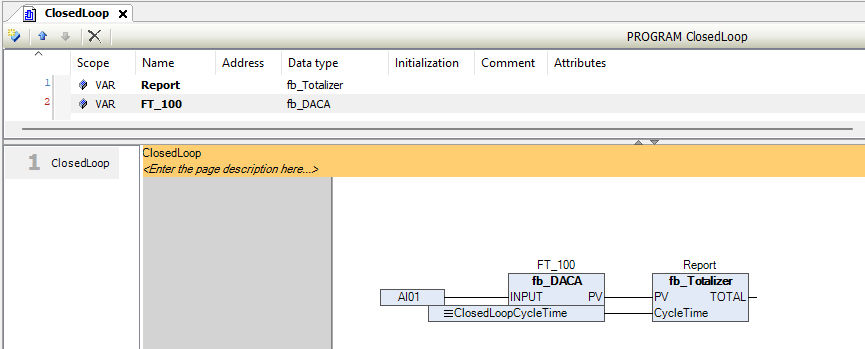TOTALIZER Block Logic Documentation
Overview
The TOTALIZER block is designed to continuously accumulate a process value over time. It is used in scenarios where total quantity needs to be calculated based on instantaneous values, such as flow, energy, or mass.
The block accounts for time-based integration and allows flexible configuration using time units (seconds, minutes, hours) and an optional conversion factor. It also provides a reset mechanism and outputs the accumulated total in real-time.
Logic Block Illustration
- The block integrates the input process value
PVby multiplying it with the cycle time. - This gives a running total over time, similar to a trapezoidal integration.
- If
RESET = TRUE, the total value is reset to0.0. - The logic assumes
PVis in consistent units (e.g., L/s or m³/h).

Showing the Shift Totalizer block in the above picture.

In the above picture, we are showing that how to use the Totalizer block
Pins Information
| Signal Name | Type | Description |
|---|---|---|
| PV | REAL | Process value to be totalized (e.g., instantaneous flow rate) |
| enTotalTime | INT | Time base selection: 0 = Seconds 1 = Minutes 2 = Hours |
| CONV_FCTR | REAL | Optional conversion multiplier for PV |
| CycleTime | REAL | PLC cycle time in seconds |
| RESET | BOOL | When TRUE, resets totalized value to zero |
| TOTAL | REAL | Accumulated total value output |
Operational Behavior
- Accumulation Logic:
- On each cycle, the block calculates:
INCREMENT = PV × CONV_FCTR × CycleTime -
INCREMENTis added to theTOTAL, adjusted according toenTotalTime. -
Time Base Handling:
enTotalTime = 0: Totalization in secondsenTotalTime = 1: Totalization in minutes → internal increment divided by 60-
enTotalTime = 2: Totalization in hours → internal increment divided by 3600 -
Reset Logic:
- If
RESET = TRUE, the total valueTOTALis reset to 0.0. - Totalization resumes after
RESETgoes FALSE.